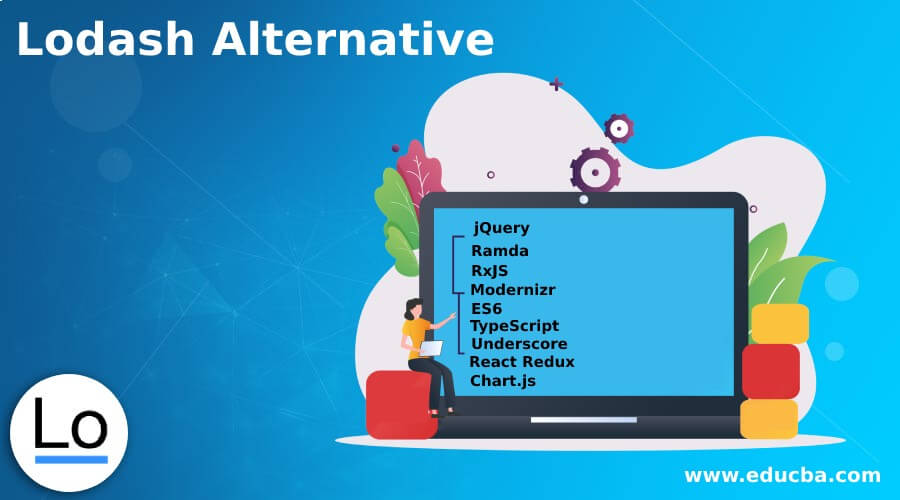Updated June 13, 2023

Introduction to Lodash
The following article provides an outline for Lodash Alternative. Lodash is a JavaScript library that uses the functional programming paradigm to provide utility functions for common programming tasks. Lodash is an open-source project that supports current environments and is provided under the MIT license. Lodash makes JavaScript easier by taking the hassle out of working with arrays, numbers, objects, strings, etc. Lodash is available in a variety of builds & module formats. There are some alternatives available in the market for Lodash that we will see here.
List of Lodash Alternatives
Given below is the list of Lodash Alternatives:
1. jQuery
jQuery is the best alternative for Lodash. jQuery is a JavaScript framework that makes traversing and manipulating the HTML DOM tree, event handling, CSS animation, and Ajax easier. It’s open-source software that’s free and uses the liberal MIT License. It allows developers to build plug-ins on top of the JavaScript library. Developers can use this to create abstractions for low-level interaction and animation, advanced effects, and themeable widgets at a high level.
2. Ramda
Ramda is a collection of functions aimed to make functional programming in JavaScript simple and powerful while remaining true to the language. Its goal is to bring functional programming to JavaScript without altering the language’s nature or feel. Ramda states that its method of operation is a more effective and efficient kind of functional programming. Its methods, in particular, are designed using a function-first approach. As a result, most methods take any required functions as their initial parameter, making composition much easier.
3. RxJS
RxJS is one of the most popular web development libraries nowadays. The case for learning Rx has never been stronger since it provides a robust, functional method for dealing with events and integration points into an increasing variety of frameworks, libraries, and utilities. RxJS comes with several utilities for creating new observables. These functions make it easier to make observables out of things like events, timers, and promises.
4. Modernizr
Modernizr is a little piece of JavaScript code that identifies whether next-generation web technologies are available in your users’ browsers. Modernizr employs feature detection to allow you to effortlessly adapt your users’ experiences depending on the actual capabilities of their browser rather than blacklisting entire ranges of browsers based on “UA sniffing.” Modernizr uses the Modernizr object to keep track of the outcomes of all of its feature detections. This indicates that a relevant property will be added for each test.
5. ES6
ECMAScript 6 is referred to as ES6. ES6 is the sixth version of ECMAScript, released in 2015 and also known as ECMAScript 2015. The most popular usage of ECMA Script is for client-side scripting, particularly on the internet. Node.js is rapidly being utilized to create server-based applications and bigger services. ES6 enables client-side languages and is becoming one of the most popular scripting languages standardized by ECMA International. This language and its specifications govern JScript, JavaScript, and ActionScript.
6. TypeScript
Typescript is a combination of JavaScript and some of JavaScript’s advanced capabilities. It’s also the result of combining a collection of tools and a language. It’s just JavaScript that works with other JS files. It’s transportable. The syntactical contract is the typescript interface; it helps define entity syntax. It defines the interface’s methods, events, and properties, all interface members. It’s also in charge of creating classes that define the members.
7. Underscore
Without altering any core JavaScript objects, Underscore.js is a utility belt package for JavaScript that provides support for the standard functional suspects (each, map, reduce, filter…) Underscore 1.x is backward compatible with any engine that fully implements ES3, while also taking advantage of upcoming capabilities like Object. Keys, typed arrays, and ES modules when they become available.
8. React Redux
Redux is a state container that helps you develop JavaScript apps that are easy to test and act reliably across client, server, and native platforms. It’s most commonly used with React as a state management tool but may also be used with any other JavaScript framework or library. Because it’s under 2KB in size (including dependencies), you won’t have to worry about it increasing the asset size of your application.
9. Chart.js
Chart.js is a community-maintained open-source library (on GitHub) that makes it simple to visualize data using JavaScript. Chartist and Google Charts are similar. It can display eight different chart types (including bars, lines, and pies), all responsive. In other words, you only need to set up your chart once, and Chart.js will take care of the heavy lifting and ensure that it is constantly readable (for example, removing some uncritical details if the chart gets smaller).
Conclusion – Lodash Alternative
In this article, we have seen various alternatives for Lodash, such as jQuery, Ramda, RxJS, Modernizr, ES6, TypeScript, Underscore, React Redux, and Chart.js.
Recommended Articles
This is a guide to Lodash Alternative. Here we discuss the introduction and list of lodash alternatives for better understanding. You may also have a look at the following articles to learn more –
